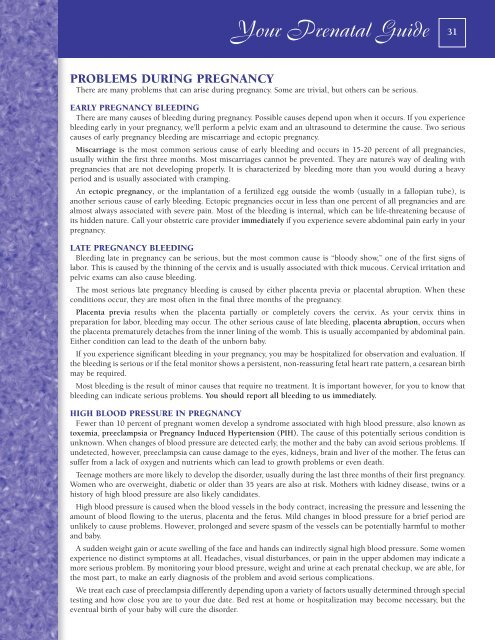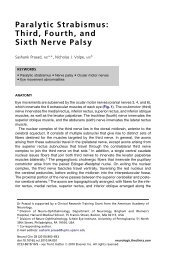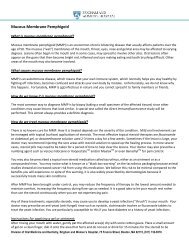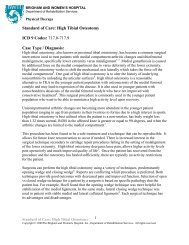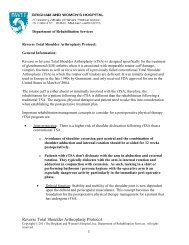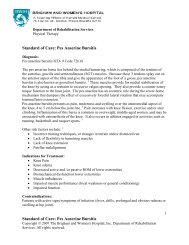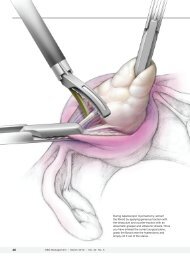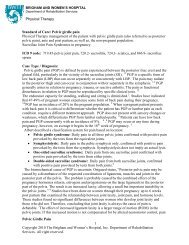Enjoying Your Pregnancy Guide to Understanding - Brigham and ...
Enjoying Your Pregnancy Guide to Understanding - Brigham and ...
Enjoying Your Pregnancy Guide to Understanding - Brigham and ...
Create successful ePaper yourself
Turn your PDF publications into a flip-book with our unique Google optimized e-Paper software.
<strong>Your</strong> Prenatal <strong>Guide</strong> 31<br />
PROBLEMS DURING PREGNANCY<br />
There are many problems that can arise during pregnancy. Some are trivial, but others can be serious.<br />
EARLY PREGNANCY BLEEDING<br />
There are many causes of bleeding during pregnancy. Possible causes depend upon when it occurs. If you experience<br />
bleeding early in your pregnancy, we’ll perform a pelvic exam <strong>and</strong> an ultrasound <strong>to</strong> determine the cause. Two serious<br />
causes of early pregnancy bleeding are miscarriage <strong>and</strong> ec<strong>to</strong>pic pregnancy.<br />
Miscarriage is the most common serious cause of early bleeding <strong>and</strong> occurs in 15-20 percent of all pregnancies,<br />
usually within the first three months. Most miscarriages cannot be prevented. They are nature’s way of dealing with<br />
pregnancies that are not developing properly. It is characterized by bleeding more than you would during a heavy<br />
period <strong>and</strong> is usually associated with cramping.<br />
An ec<strong>to</strong>pic pregnancy, or the implantation of a fertilized egg outside the womb (usually in a fallopian tube), is<br />
another serious cause of early bleeding. Ec<strong>to</strong>pic pregnancies occur in less than one percent of all pregnancies <strong>and</strong> are<br />
almost always associated with severe pain. Most of the bleeding is internal, which can be life-threatening because of<br />
its hidden nature. Call your obstetric care provider immediately if you experience severe abdominal pain early in your<br />
pregnancy.<br />
LATE PREGNANCY BLEEDING<br />
Bleeding late in pregnancy can be serious, but the most common cause is “bloody show,” one of the first signs of<br />
labor. This is caused by the thinning of the cervix <strong>and</strong> is usually associated with thick mucous. Cervical irritation <strong>and</strong><br />
pelvic exams can also cause bleeding.<br />
The most serious late pregnancy bleeding is caused by either placenta previa or placental abruption. When these<br />
conditions occur, they are most often in the final three months of the pregnancy.<br />
Placenta previa results when the placenta partially or completely covers the cervix. As your cervix thins in<br />
preparation for labor, bleeding may occur. The other serious cause of late bleeding, placenta abruption, occurs when<br />
the placenta prematurely detaches from the inner lining of the womb. This is usually accompanied by abdominal pain.<br />
Either condition can lead <strong>to</strong> the death of the unborn baby.<br />
If you experience significant bleeding in your pregnancy, you may be hospitalized for observation <strong>and</strong> evaluation. If<br />
the bleeding is serious or if the fetal moni<strong>to</strong>r shows a persistent, non-reassuring fetal heart rate pattern, a cesarean birth<br />
may be required.<br />
Most bleeding is the result of minor causes that require no treatment. It is important however, for you <strong>to</strong> know that<br />
bleeding can indicate serious problems. You should report all bleeding <strong>to</strong> us immediately.<br />
HIGH BLOOD PRESSURE IN PREGNANCY<br />
Fewer than 10 percent of pregnant women develop a syndrome associated with high blood pressure, also known as<br />
<strong>to</strong>xemia, preeclampsia or <strong>Pregnancy</strong> Induced Hypertension (PIH). The cause of this potentially serious condition is<br />
unknown. When changes of blood pressure are detected early, the mother <strong>and</strong> the baby can avoid serious problems. If<br />
undetected, however, preeclampsia can cause damage <strong>to</strong> the eyes, kidneys, brain <strong>and</strong> liver of the mother. The fetus can<br />
suffer from a lack of oxygen <strong>and</strong> nutrients which can lead <strong>to</strong> growth problems or even death.<br />
Teenage mothers are more likely <strong>to</strong> develop the disorder, usually during the last three months of their first pregnancy.<br />
Women who are overweight, diabetic or older than 35 years are also at risk. Mothers with kidney disease, twins or a<br />
his<strong>to</strong>ry of high blood pressure are also likely c<strong>and</strong>idates.<br />
High blood pressure is caused when the blood vessels in the body contract, increasing the pressure <strong>and</strong> lessening the<br />
amount of blood flowing <strong>to</strong> the uterus, placenta <strong>and</strong> the fetus. Mild changes in blood pressure for a brief period are<br />
unlikely <strong>to</strong> cause problems. However, prolonged <strong>and</strong> severe spasm of the vessels can be potentially harmful <strong>to</strong> mother<br />
<strong>and</strong> baby.<br />
A sudden weight gain or acute swelling of the face <strong>and</strong> h<strong>and</strong>s can indirectly signal high blood pressure. Some women<br />
experience no distinct symp<strong>to</strong>ms at all. Headaches, visual disturbances, or pain in the upper abdomen may indicate a<br />
more serious problem. By moni<strong>to</strong>ring your blood pressure, weight <strong>and</strong> urine at each prenatal checkup, we are able, for<br />
the most part, <strong>to</strong> make an early diagnosis of the problem <strong>and</strong> avoid serious complications.<br />
We treat each case of preeclampsia differently depending upon a variety of fac<strong>to</strong>rs usually determined through special<br />
testing <strong>and</strong> how close you are <strong>to</strong> your due date. Bed rest at home or hospitalization may become necessary, but the<br />
eventual birth of your baby will cure the disorder.


